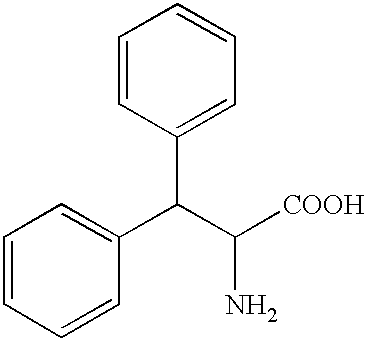Penta-or tetrapeptide binding to somatostatin receptors and the use of the same
a technology of somatostatin receptors and tetrapeptides, which is applied in the direction of cyclic peptide ingredients, animal/human proteins, radiation therapy, etc., can solve the problems of hardly suitable as a therapeutic agent, reduce the possibility of use, and misery of chronic pain, and achieve the effect of slow decomposition and diminution of inflammation
- Summary
- Abstract
- Description
- Claims
- Application Information
AI Technical Summary
Benefits of technology
Problems solved by technology
Method used
Image
Examples
example 1
[0136] Preparation of the Z Group
[0137] Preparation of the furanoid Z group from diacetone glucose which is available commercially and inexpensively
[0138] Both groups Z1 und Z2 are prepared in accordance with the above scheme 1.
[0139] 1,2:5,6-Di-O-isopropylidene-3-O-triflyl-.alpha.-D-glucofuranose: Triflic anhydride (54.2 g, 0.19209 mol) was slowly added with stirring to a solution of diacetone glucose (25 g, 0.96 mol) and pyridine (30.39 g, 0.384 mol) in CH.sub.2Cl.sub.2 (1 l) in a 3-neck flask at -10.degree. C. (acetone-ice cooling bath) (L. D. Hall, D. C. Miller, Carbohydr. Res. 1976, 47, 299; R. W. Binkley, M. G. Ambrose, D. G. Hehemann, J. Org. Chem. 1980, 45, 4387). The pyridinium triflate salt precipitated and the solution turned brown. The reaction was completed after 1.5 hrs. (TLC control: AcOEt / hexane 2:1).
[0140] The reaction mixture was added to 1 l of ice water. The aqueous phase was extracted with CH.sub.2Cl.sub.2 (4.times.). The organic phase was dried with MgSO.sub.4 ...
example 2
[0161] Parallel Production of TG and TH:
[0162] Resin Loading
[0163] According to standard methods, TCP resin (1.3 g) was loaded with 629 mg of Fmoc-Tyr-OH, 2.77 ml of collidine in 10 ml of DCM in a 20 ml syringe. The loading was determined to be 0.477 mmol / g resin by gravimetry.
[0164] 165 mg of the resin loaded with Fmoc-Tyr-OH as above were allowed to swell for 2 hrs. in a 5 ml syringe with frit in NMP.
[0165] Fmoc-deprotection: With agitation, the resin is treated with 20% piperidine in NMP (3.times.10 min.) and then washed with NMP (5.times.2 min.) with agitation.
[0166] 1.sup.st Coupling
[0167] The Fmoc-protected sugar amino acid 1 (50,5 mg, 1.5 equiv) is dissolved in 2 ml of NMP together with HOAt (16 mg, 1.5 equiv), HATU (45 mg, 1.5 equiv) and collidine (156 .mu.l, 15 equiv). This solution is charged into the syringe containing the Tyr-resin and allowed to react with agitation for 3-4 hours, followed by washing with NMP under agitation (5.times.1 min.) A few resin beads were taken...
example 3
SGnc 18: c[-D-Trp-Lys-Thr(OTrt)-Z2-Phe-]
[0190] Loading with Resin:
[0191] TCP-resin (2 g) was loaded with 933 mg (1.2 equiv) of Fmoc-Phe-OH, DIPEA (2.5 equiv, 1.05 ml) in 16 ml of DCM in a 20 ml syringe according to standard methods. By gravimetry, the loading was determined to be 0.677 mmol / g resin. 52.4 mg of the Fmoc-Phe-OH loaded resin were allowed to swell with frit in a 2 ml syringe in NMP for two hrs.
[0192] Fmoc-deprotection: With agitation the resin is treated with 20% piperidine in NMP (3.times.10 min.) and then washed with NMP (5.times.2 min.) with agitation.
[0193] 1.sup.st Coupling
[0194] The Fmoc-protected sugar amino acid 2 (24.3 mg, 1.5 equiv) is dissolved in 194 .mu.l of DMF together with HOAt (7.3 mg, 1.5 equiv), HATU (20.25 mg, 1.5 equiv) and collidine (70.7 .mu.l, 15 equiv). This solution is charged into the syringe containing the Phe-resin and allowed to react with agitation for 3-4 hours, followed by washing with NMP under agitation (5.times.1 min.) A few resin bea...
PUM
| Property | Measurement | Unit |
|---|---|---|
| Fraction | aaaaa | aaaaa |
| Fraction | aaaaa | aaaaa |
| Fraction | aaaaa | aaaaa |
Abstract
Description
Claims
Application Information
 Login to View More
Login to View More - R&D
- Intellectual Property
- Life Sciences
- Materials
- Tech Scout
- Unparalleled Data Quality
- Higher Quality Content
- 60% Fewer Hallucinations
Browse by: Latest US Patents, China's latest patents, Technical Efficacy Thesaurus, Application Domain, Technology Topic, Popular Technical Reports.
© 2025 PatSnap. All rights reserved.Legal|Privacy policy|Modern Slavery Act Transparency Statement|Sitemap|About US| Contact US: help@patsnap.com



